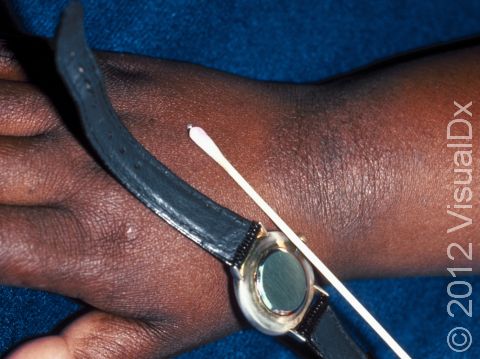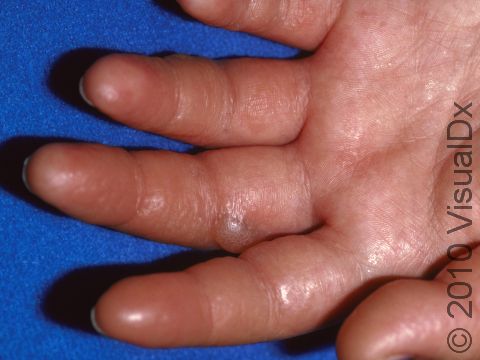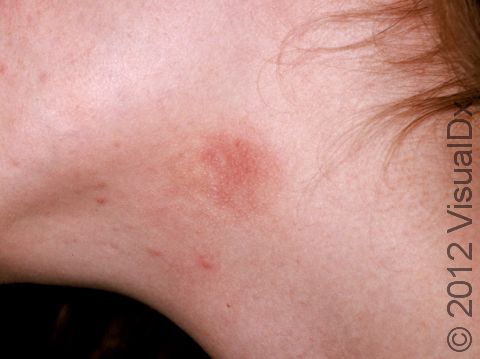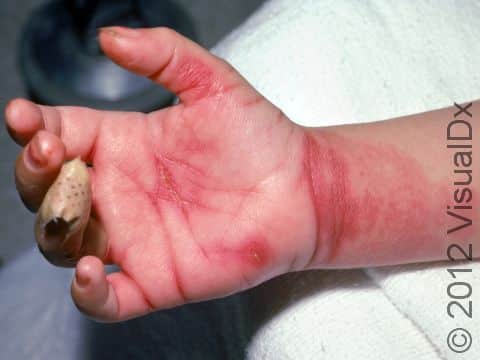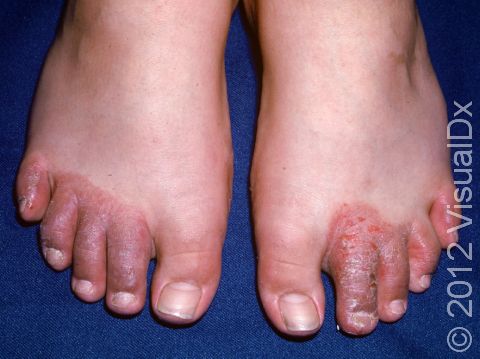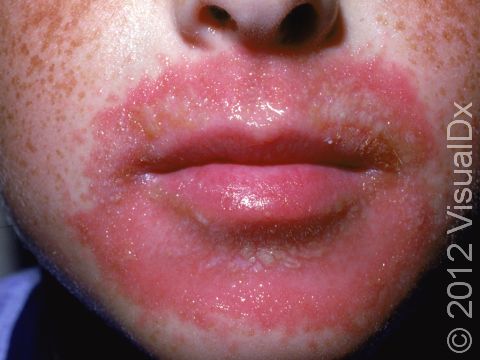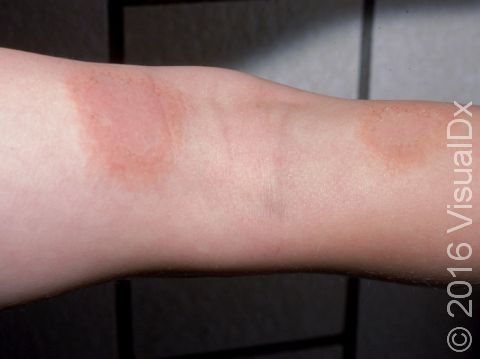Allergic Contact Dermatitis (Pediatric)
Allergic contact dermatitis is a type of eczema (atopic dermatitis) that occurs to a substance (the allergen) touching the skin. Unlike irritant contact dermatitis, which occurs at the time of the allergen touching the skin, allergic contact dermatitis occurs around 24-72 hours after exposure. Common allergens are nickel, chromates, rubber chemicals, and neomycin (an antibacterial medication).
- Nickel is found in jewelry, belt buckles, and metal closures on clothing.
- Chromates are found in shoe leathers.
- Rubber chemicals are found in gloves, balloons, and elastic in clothes.
- Neomycin is common in triple-antibiotic first-aid ointments such as Neosporin (and generic versions of Neosporin) and other combination preparations containing other antibacterials and corticosteroids, as well as other topical ointments, creams, and lotions. It may also be found in eye medications and eardrops.
- Common allergen-containing products include sunscreens (oxybenzone [benzophenone-3]), cosmetics, soaps, dyes, and jewelry.
- Other frequent triggers are fragrance, formaldehyde, lanolin, and other chemicals that are common in the environment.
- Poison ivy is a frequent cause and is discussed separately.
Who's At Risk?
Allergic contact dermatitis can occur at any age, but it is more common in adults, and women are affected more often than men. Allergic contact dermatitis in children is more common after age 5 years but can occur in younger children. Allergic contact dermatitis is becoming more common in children.
Signs & Symptoms
The affected areas of skin can look different on different body areas and on different people. In children, the head, neck, hands, legs, and diaper area are the most common areas of involvement. The feet and lips are more commonly involved in children than in adults.
There is often redness or other skin color changes in the affected areas, and there may be vesicles or bullae (blisters of different sizes), oozing, and crusting. Or there may be scaly plaques (elevated areas larger than a thumbnail). The lesions may have distinct borders with straight edges and sharp angles. In lighter skin colors, the areas are often pink or red, and in darker skin colors, the redness may be harder to see or may look more purple or gray. Affected areas are typically severely itchy.
When the dermatitis is chronic, the elevated areas can become thickened. Scratching the skin can cause cracks that may become infected with bacteria.
Self-Care Guidelines
- Ideally, your child should avoid whatever is triggering their dermatitis, if known. If you’re not sure what caused the allergic contact dermatitis or if your child is prone to allergies or has sensitive skin, it may be helpful to avoid common triggers, such as fragrance, lanolin, nickel, etc. The American Contact Dermatitis Society’s Contact Allergen Management Program (CAMP) and SkinSAFE can help you find products that are free of identified allergens.
- Apply cool water compresses to cleanse the area, and then apply over-the-counter 0.5%-1% hydrocortisone cream or ointment twice daily.
- Calamine lotion and oral antihistamines (chlorpheniramine or diphenhydramine) may help reduce the itching.
- Avoid using topical antihistamines, such as Benadryl lotion, as these may irritate the skin. Avoid topical antibiotics containing the common allergens bacitracin and neomycin.
- Note that many popular products marketed as hypoallergenic or unscented may contain allergens or irritants.
Treatments
Treatment is aimed at preventing contact with the allergen. Symptoms may be controlled with oral antihistamines.
Additionally, your child’s medical professional may prescribe:
- A low-potency topical steroid for use on the thin skin of the face and skinfold areas.
- A medium-potency topical steroid for rash occurring on the arms or legs (extremities) or trunk.
- A high-potency topical steroid for rash occurring on the hands or feet.
- A course of an oral steroid (eg, prednisone) in severe cases involving large body areas.
The medical professional may do patch testing (application of a series of chemicals under patches, usually applied to the back, and left on for 48 hours) to check for potential contact allergies if the cause is not known.
Visit Urgency
See your child’s medical professional for evaluation if the rash does not improve with self-care measures or if it keeps coming back.
References
Bolognia J, Schaffer JV, Cerroni L. Dermatology. 4th ed. Philadelphia, PA: Elsevier; 2018.
James WD, Elston D, Treat JR, Rosenbach MA. Andrew’s Diseases of the Skin. 13th ed. Philadelphia, PA: Elsevier; 2019.
Kang S, Amagai M, Bruckner AL, et al. Fitzpatrick’s Dermatology. 9th ed. New York, NY: McGraw-Hill Education; 2019.
Paller A, Mancini A. Paller and Mancini: Hurwitz Clinical Pediatric Dermatology. 6th ed. St. Louis, MO: Elsevier; 2022.
Last modified on July 10th, 2025 at 2:24 pm

Not sure what to look for?
Try our new Rash and Skin Condition Finder
